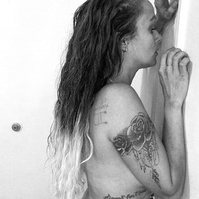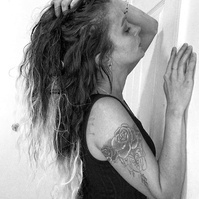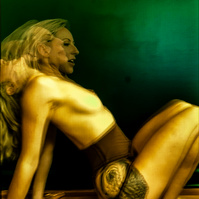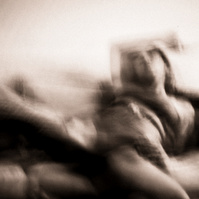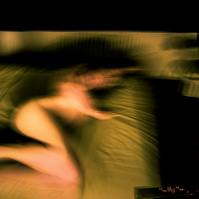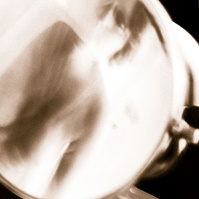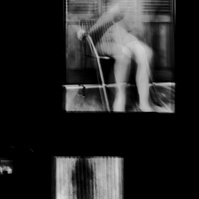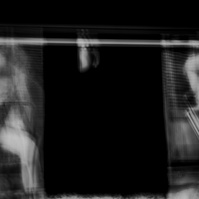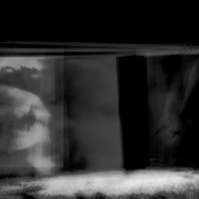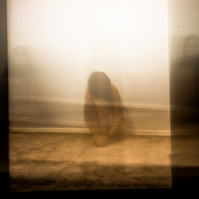Returning to remote photography after a hiatus. Sometimes you need to create and don’t want to deal with logistics and complexities and travel and all of the following. Remote photography allows us to connect with new and interesting people. It also lets me grow as a photographer and as an artist. As artists we need to constantly challenge ourselves. Try something new. A large part of photography is our emotional reactions and remote photography allows us to explore this further.
For whom are these things made? This is what I’ve been contemplating lately. My work has an audience of two: me and my subject. Yet, for some strange reason I still post here and write these things. Why? Is it the hope of having an audience of more than two or do I write for an audience of one?
Is art an invention or a discovery? Do we create brand new things that do not exist in nature or do we find ways to reveal nature itself? As a photographer it is impossible to invent anything. You are bound and constrained by reality. This might seem limiting at first but ask yourself does reality have any limitations? We only see a fraction of the light and color spectrum. Our world is full of movement. So how do we represent this as a photographer? How do we discover these things?
It is beyond time that photography became much more than saving a snapshot of reality so we can remember it later and instead it is time photography became a tool with which we explore reality itself.
For these photos I went back to selfies instead of recording the FaceTime session. Doing the same process over and over can sometimes lead to the same results so it helps to change up your process.
I find working with selfies to be a lot more difficult. The motion blur / abstraction with moving images is part of the process. But with selfies you have to create the motion blur / abstraction. In this sense working with selfies is a lot more like painting with your camera.
“I enjoyed collaborating with fame in can. He was patient, understanding and I love his creative eye.”
“Editing” these photos is such a strange experience. How do you know what a photo, that isn’t depicting reality, should look like? I never have any preconceived ideas when I start a photoshoot. I’m also not even really composing or thinking when I’m photographing the videos for this project; I’m just collecting data. It is important to note that the effects are all in camera, there are no multi layers or anything like that. There is zero photoshop. The art happens in lightroom.
But this brings us back to the question of how do you know what to do and more importantly when to stop? I mean you cannot try all permutations, that is impossible. My answer is you let the photo speak to you. For me, this is all based on feelings. I just instinctively and intuitively know what to do and when to stop. I just look at the photo and when I get a certain feeling I stop. I think next time I might just edit some of these photos blindfolded and see what the heck happens.
“I had a great time working on this project with Payam! He was very communicative and patient throughout our interaction. His work is beautiful and I would recommend working together!”
What is the role of nudity in abstract photography? I acknowledge that employing nudity in a project where the final product is abstract, and thus does not depict the nudity, is strange and might seem superfluous but I believe it is integral.
Photography is the freezing of emotions. I have found that nudity creates not only the greatest range of emotions but the most honest. The fundamental truth is we just act differently in a state of undress. But nudity doesn’t only affect the emotions of the model it also affects the photographer. Not only do we act differently in a state of undress we also feel differently when we see someone in such a state.
Unfortunately, nudity has been commercialized and demonized in our society. If a women decides, of her own free will and volition, to pose nude she is smut shamed and given all kinds of labels. Social media bans anyone with the audacity to post nudity. So the fundamental question is how do we redeem in nudity in a world where we cannot depict it?
The answer, I have come up with, is we obfuscate it. By abstracting the final photo it allows me to get it past the social media censors without blunting the emotional power of the original photo. The abstraction of the photo also allows the photo to pass the social filters we have setup towards nudity and for us to have honest and complex emotional reactions.
“I truly enjoyed the experience and collaboration involved in this project. I found Payam to be easy to work with and open minded in the creative process. I truly hope to work with him in the future!”- Geneva
Why? I am continually asking myself this question. Why do I do this? Our modern world is an A to be proposition. We do A in order to get to B. But art isn’t an A to B proposition. The truth of the matter is no one sees this stuff; I am having a conversation with myself. I think if modern art has taught us anything it is that the process matters. The mere act of doing something matters. Life does not need to be this grand chain of things where everything is linked. It can be micro moments where you just do something because you want to. I think this is what is missing in our modern world. These small spaces where you are free to just do what you want without long term consequences. This project strives to be such a space.
We did something a little different for this set. The model and a friend recorded videos and I then used the videos to create the photos. One of the main aspects of this project is how does the medium affect the subject. So for this set I tried to explore whether having the model be filmed by someone she knew would make any difference in the final product. I do not really have an answer to this.
One thing is that it helps me detach somewhat from the data gathering process. I think this is a valid approach because it allows the gathering of data that is not biased by me and my imagination.
Is abstract art random?
The answer depends on the artist. For me it is random.
I have absolutely no idea what the final photo will look like. When the subject is moving around I have no idea what that will do or what type of image it will create.
For me this is data art. During the facetime session I try and record as much data as possible. I have the subject move in as many ways as possible.
So the second question is does it matter what the subject does? If this is truly random does it matter how the subject moves? What the subject wears? If the subject wears nothing? What the subject does during the shoot?
The answer is yes. Abstract art shouldn’t actually be called abstract art. Abstract art is about taking something abstract, primarily emotions, and making it tangible / concrete. So in this sense what the subject does is rather important. In essence they are inspiring me. I then take that emotion I feel while viewing them, mix it up with my own emotions, and generate the work.
In many ways these are self portraits.
Everytime I do one of these shoots, I try and do something different. This project has been a great way for me to stretch my creativity muscle. I am really amazed at how many different ways this project can be done. Every time I think I am out of ideas and I struggle, a light bulb turns on and magic happens.
Is this the final boss? I think I might have gotten to the final stage of abstract photography; I have abandoned the human form altogether. Modern art is like an iceberg– you only see ten percent of it. You never see the process. Yes, I could create a detailed post of what I did and how I got here, but I want to preserve the magic. I do not care if people replicate my work. There is just something about explanation that makes it less magical and for me the magic is the most important part. But I will go into the process a little.
Yes I did use a colored filter to achieve the red. The yellow is a happy accident and a byproduct of light. Yes there was a model, thank you Lauren, but in the end she turned out to be the paintbrush and light the paint. I just find it really magical that you can take ordinary reality and get this from it, simply by manipulating light.
Now comes the hard part of figuring out how to move ahead from this and create something new.
I never know what the final product will be when I start a shoot. The main reason is I do not want to limit my imagination. You would think that the final result would thus always be the same but somehow it is usually radically different than what I even could imagine. I think art wants to be created. I think art exists in the ether and artists are like radios who are tuned into that ether and can just follow instructions. If an artist ever tells you what they created is exactly what they envisioned they are either a liar or a terrible artist.
I am just in awe with these photos. I seriously have no idea how these came to be. My process starts with the recording of the FaceTime session– a person in a room, very ordinary and non-descript. I then replay that video and photograph it. I do not choose a specific section. I really do try and be as hands off as possible; let things just be. The magic really starts in lightroom. Photography has to be anchored in reality but I do think we can float in the clouds a little.
Everytime I do one of these sessions I try and do something different. I have, so far, been pleasantly surprised with what I have been able to create. The beauty of photography has always been the manipulation of reality; to see what you can create while still staying within the confines of real objects and photographs.
Most people hold repistational art in much higher esteem than abstract art. If you can draw something that looks exactly like the object itself than you are a very talented artist but if you instead represent that object in some weird, abstract way then people just think the reason you are doing that is because you cannot draw.
I think the main reason for this is because most people have attempted representational art and failed, but they have never attempted abstract art. Why?
Well because with representational art at least you know where to start; no such thing exists with abstract art. This is why I have always felt abstract art was much more difficult.
This project has given me a newfound appreciation for abstract art. The good thing about abstract photography is at least you know where to start; multiple exposures. The question then is where do you go from there? I had to invent an entire new technique for the previous abstract photos you saw. Coming up with that was rather difficult. But the real problem was these photos. What the heck do you do after the new technique?
Abstract photography has an actual limit; it cannot be pure abstraction. It still has to have some tangential relationship with the object you are representing, you started with. So really there are only a small finite number of things you can do in abstract photography. Compounding this issue is the fact it still needs to adhere in some ways to traditional aesthetics and rules of photography.
So it has been a really interesting journey figuring all of this out. I am amazed every time at the result. I think what amazes me the most is that somehow out of the chaos and randomness a coherent story emerges. It really makes you think if there really is randomness in the universe?
When photography became digital the magic died. A lot of people do not consider photography a real art form because they think everything can be recreated if you have the right camera, software, or watch the right youtube video; it is all digital trickery. For most people something is art if they cannot do it themselves. In some ways they are correct and in many ways they are incorrect. But I wanted to try and create something that could not be replicated; that was in many ways impossible.
The effect you see in this abstract photo (and all abstract photos in this blog) were all done in camera. But even if you knew the camera settings and how it was all technically done that is only half of the equation. I used a really clever and unusual way to create the motion. Finally, the moment that was captured can also never be duplicated.
I think the main point of all of this is not to show off but to remind people that photography is an art form and it can create the impossible.
All art will inevitably become abstract art. Representational art, by its very nature, is limited to only one facet of our existence- what we see. Abstract art is what we feel. Abstract art is universal. Abstract art is taking the human soul and putting it on a tangible medium. The question then is how does photography become abstract? Can it?
Photography is bound by reality. If you want to photograph a pink elephant you have to find a pink elephant. So who then can you have abstract photography?
I have been trying to figure this out as long as I have been an artist. This is as close as I have ever been able to get to that elusive goal. I need to make something clear. These are not photoshopped images. Yes I did some manipulation in lightroom but these are not layered images nor are they composites. All of these effects were done in camera. This is why abstract photography is so difficult. You have to find something to photograph that will lead to abstraction. But you cannot hide the source totally, for if you do then it no longer is photography. Thus, abstract photography must both be representational and abstract at the same time. No wonder it is so damn difficult.
“When thinking about my activity on Instagram and other social media, I realized I have almost completely stopped taking pictures of myself. I am definitely swayed by the photos I see and compare myself to unrealistic ideals, but I have worked to be at a place where I think I’m cute, sexy and beautiful. Despite that I feel like I don’t fit an aesthetic that is “good enough” to share on the internet and that’s why I dont post. I guess I have this idea in my head of what aesthetics are worthy of the internet as if it’s a different standard. As if I cannot blend whatever aesthetics I identify with. This is definitely something I want to delve deeper in with myself. ” - Tori Fleury
The point of a virtual shoot is not to recreate what you would in a studio. The point of a virtual shoot is to do something that would not be possible in a traditional studio shoot or any other medium. This is rather difficult with a virtual shoot. So what makes a virtual shoot different?
1) being recorded
How you photograph something changes what you photograph. The mere act of going on cam and being recorded changes your behavior. It is this change in behavior that you are trying to capture. This is rather difficult because you do not know the person you are having the shoot with nor do you know what their normal behavior is like. That is why you try and break societal rules in your shoot. This is why I prefer regular women and the role of nudity in my work.
2) real time
What sets a virtual shoot apart from a selfie shoot is that it occurs within a fixed time period and in real time. This allows the observer to “direct” the subject. But not in the traditional manner. This is still a data art project and thus the objective is to gather the widest data set possible. So what you are directing them to do is get as much data as possible; move away from the camera, move closer to the camera, move the light etc. You are in essence directing the camera not the person; but since the camera cannot move the person must.
3) the screen
If you do photograph the screen there has to be a point to it. You have to be able to create something that you simply could not by simply capturing the screen. So the medium you replay the video in is important. The inherent nature of monitors, computer screens, and cell phones need to be explored to learn how they can add to the creative process.
We left off asking what is the role of the photographer in our new “Truth” paradigm? Does the photographer even have a role? I think the answer is that we have to create an art world in which multiple ideas exist at the same time. We also have to create new art forms. So this new paradigm does not replace what a traditional photographer is, we need both of them. But this new paradigm provides a digital artist with their most precious commodity- data.
Digital art at its heart is the collection and manipulation of data. For me personally what I seek to do is find the inherent story in an image and highlight it. Photos speak to me but I understand that is not the case for everyone. So I try and make the story I see more accessible to others.
This is a perilous tightrope walk. On the one hand you need to change a photo to highlight certain aspects of it but on the other hand you still need to keep its raw original quality. What I try and do with all of my photos is make the viewer feel what I felt when I took that photo.
It is kind of interesting and weird doing the same thing with this project because I never took the photo. I guess I am playing the role of a mind reader.
What is the role of photography in our society? Does it even have one? Once upon a time the world was unknown. Most people never travelled further than their village or their state. In this world the role of photography was documentary; to photograph all the things people had never seen or didn’t know they even existed. With the maturation of technology the world began to shrink. We now live in a world where anyone can go on the internet and see anything and everything; there is very little mystery left. So what is the role of photography in this world?
I think many view it in a commercial fashion. Photography is the ability to take beautiful photos; to alter reality. When people think of photography most think of the altered / photoshop photos they see on Instagram. But this is not photography, this is retouching.
Ironically, the role of photography has reverted back to its original role of truth telling and reality. We have strived so far from the truth of beauty, what with photoshop and filters, that the role of photography has become to remind us what women really look like / what true beauty is.
But if the role of photography is naked honesty that removes the photographer from the process. If you want to tell the “Truth”, you then need to remove the editor / the author- and that is what a photographer is. If you want to tell the “Truth” you should mount your camera on a tripod, set it to take photos at random times, and upload those photos directly to social media– eliminate the editor as much as possible.
So what then become of the photographer?
This is why I do what I do. The first issue of this magazine was about social media and sadness. About how what we see, even though we know it is fake and manipulated, still changes our perception about ourselves. I think the biggest mistake we make is we assume we are all brain; that our animalism has been totally eliminated. Our survival was based on the simple fact that what we saw was true. This is still retained in our dna and hard wired into our brains. Thus, when you see a photoshopped file that part of your brain says it is true. Furthermore, the biological imperative in you says women who look like that will be biological successive and you have a further drive to look like the fake photo. It is time to change the narrative. Post and share photos that are different. No photoshop / no makeup. Sad photos. Dark photos. Above all else original photos. Let the young women out there see all of the colors in the rainbow and see all forms of beauty. And if they do not see themselves, empower them to create their own art.
Obfuscation. One of the main questions of this project is how much do you change the photos from the original? How much do you hide the fact that they are selfies. Am I trying to replicate as close as possible what I would do in traditional photoshoot or am I trying to create something distinct? The answer, as I progressed through the project, became both. Some photos are mere data to me, something I can manipulate in a way to tell my story. The process of them being selfies was important but that aspect did not add anything to the photo. Others like this, I wanted to preserve and highlight the fact they are selfies. One of the main points of this project is to elevate selfies from low art to the same level as my traditional photography projects. I want to inspire people to create their own art. I want people to stop fetishizing camera equipment and instead just create- but I want intentionality and thought behind that creation.
I did something really different for this photo- color! I was really inspired by the photo so I decided to experiment with CMYK. For those who do not know what CMYK is it is a four color separation- it is what was used in offset printing. I really love how it came out. I decided to also include a black and white photo as a nice contrast. Overall I am very happy with how this project is coming along and there are more photos to come.
More from the selfie project. I am always amazed at the innate artistic ability of people. When the model sent me these photos I was blown away by how good they were. I don’t think people know how impossible it is to take photos of yourself. Not from a technical standpoint but from a creative standpoint. Photography is the marriage between the perspective of the photographer and the model. It is a conversation two people are having. When someone is both it is nearly impossible to keep this duality in tact. Suffice it to say I am in love with these photos. More to come.
